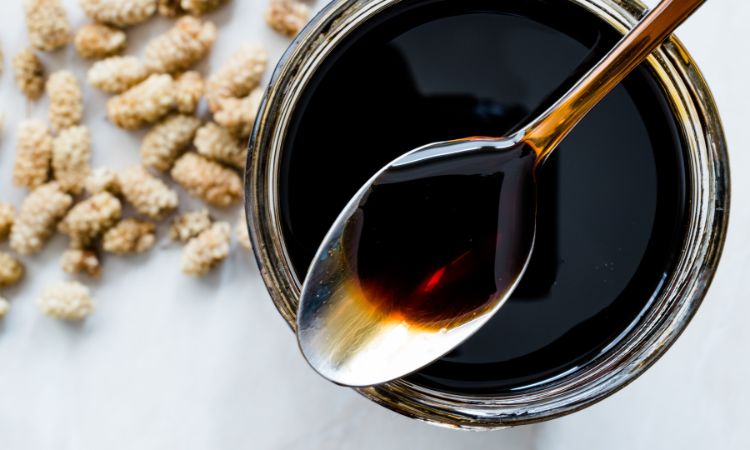Blackstrap molasses, a thick, dark syrup byproduct of sugar cane or sugar beet processing, has garnered significant attention in various industries due to its rich nutritional profile and versatile applications. The global blackstrap molasses market size reached a value of approximately USD 11.25 billion in 2023. This market is projected to grow at a compound annual growth rate (CAGR) of 2.8% between 2024 and 2032, reaching a value of around USD 14.45 billion by 2032. Understanding the dynamics of this market can provide valuable insights for stakeholders, investors, and consumers alike.
1. Market Overview
Blackstrap molasses is not just a sweetener; it is packed with essential vitamins and minerals, making it popular in health foods, animal feeds, and various industrial applications. The market for this product is driven by increasing awareness of health benefits, the rise of natural and organic food products, and the growing demand for sustainable and natural ingredients across various sectors.
Key Drivers of Market Growth
- Health Consciousness: As consumers become more health-conscious, they are increasingly turning to natural sweeteners like blackstrap molasses, which is rich in iron, calcium, magnesium, and potassium.
- Sustainable Practices: The push for sustainability in food production and animal husbandry has led to increased interest in using natural products, including blackstrap molasses.
- Versatility: Its application spans various industries, from food and beverages to pharmaceuticals and animal feed, which diversifies its market reach.
2. Market Segmentation
The blackstrap molasses market can be segmented into different categories, providing a clearer picture of its landscape.
A. By Form
- Liquid: The liquid form of blackstrap molasses is the most widely used, primarily in food products and fermentation processes.
- Powder: The powdered form is gaining popularity due to its ease of use in baking and food formulations.
Both forms hold significant market share, with the liquid segment being the leader due to its established applications.
B. By Application
- Industrial Fermentation: This application segment utilizes blackstrap molasses as a carbon source in fermentation processes, particularly in the production of biofuels and alcoholic beverages.
- Food and Beverages: The food industry consumes a significant portion of blackstrap molasses, using it as a sweetener, flavor enhancer, and nutrient additive.
- Pharmaceutical: In pharmaceuticals, blackstrap molasses is used for its nutritional benefits, often in dietary supplements.
- Animal Feed: The animal feed segment utilizes blackstrap molasses to enhance palatability and provide essential nutrients to livestock.
- Others: Other applications include cosmetics and personal care products, where molasses is used for its moisturizing properties.
C. By Distribution Channel
- Offline: Traditional retail outlets and specialty stores dominate this channel, offering consumers a tactile experience before purchasing.
- Online: The online distribution channel is rapidly growing, driven by the rise of e-commerce and changing consumer shopping habits.
The online segment is expected to see substantial growth, particularly as more consumers turn to digital platforms for their purchases.
3. Regional Analysis
The global blackstrap molasses market is not uniform; it varies significantly by region, influenced by local consumption patterns, agricultural practices, and economic conditions.
- North America: The U.S. leads in market share due to high consumption in food products and animal feed.
- Europe: In Europe, there is an increasing demand for natural sweeteners, with countries like Germany and the UK leading the charge.
- Asia-Pacific: Rapid industrialization and population growth in countries like India and China are driving demand. Additionally, increasing health consciousness is boosting the market.
- Latin America and Middle East & Africa: These regions show promising growth potential, with emerging markets focusing on sustainable agriculture and organic food production.
4. Market Dynamics
Understanding the market dynamics through frameworks like SWOT analysis and Porter’s Five Forces can provide deeper insights.
A. SWOT Analysis
- Strengths: Blackstrap molasses is rich in nutrients, making it a preferred choice for health-focused consumers and industries.
- Weaknesses: It faces competition from alternative sweeteners, which may impact market share.
- Opportunities: The growing demand for natural ingredients presents opportunities for expansion in various sectors, including health foods and organic products.
- Threats: Fluctuating sugar prices and regulatory challenges in different regions could pose risks.
B. Porter’s Five Forces Analysis
- Bargaining Power of Suppliers: The number of suppliers is relatively limited, giving them moderate power.
- Bargaining Power of Buyers: As more options become available, buyers’ power is increasing, leading to price competition.
- Threat of New Entrants: While the market has established players, new entrants can emerge, especially in niche markets.
- Threat of Substitutes: The availability of alternative sweeteners poses a threat, particularly in health-focused segments.
- Industry Rivalry: Competition is fierce, with several established companies vying for market share, prompting continuous innovation.
5. Competitive Landscape
The competitive landscape of the blackstrap molasses market includes several key players, each employing various strategies to maintain and grow their market share. Companies focus on product innovation, strategic partnerships, and expanding distribution networks to cater to a growing consumer base.
Recent developments in the industry, including sustainability initiatives and product diversification, highlight the dynamic nature of the market.
6. Future Outlook and Forecast (2024-2032)
Looking ahead, the blackstrap molasses market is poised for steady growth. With a projected CAGR of 2.8%, the market is expected to reach around USD 14.45 billion by 2032. Factors such as increased health awareness, the demand for sustainable products, and the rise of e-commerce are likely to propel this growth.
Strategic Recommendations
For stakeholders, it is crucial to focus on innovation, sustainability, and consumer engagement. Investing in research and development can lead to new applications and formulations, while enhancing online presence can capture the growing e-commerce market.
